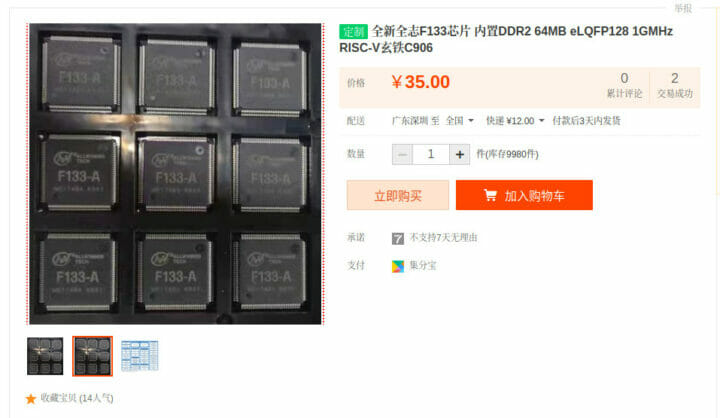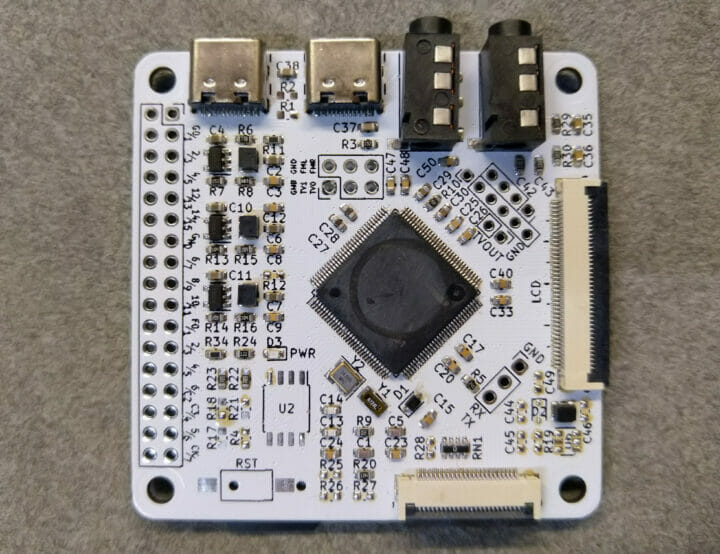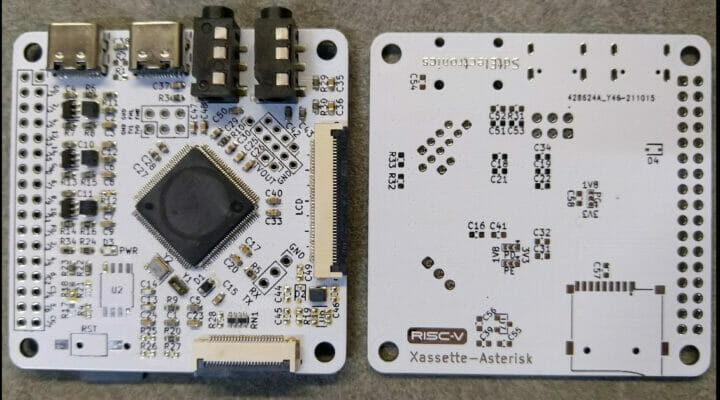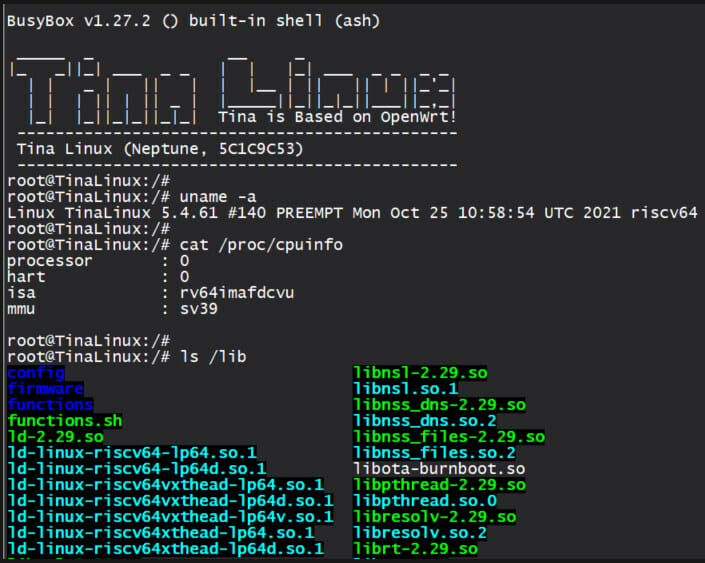We covered Allwinner D1s RISC-V processor with 64MB built-in RAM a few days ago, and we’ve just found out about Xassette-Asterisk, an open-source hardware board based on the processor that runs Linux (OpenWrt) and is said to cost less than $10 to make.
This is significantly cheaper than the Allwinner D1 based Nezha RISC-V Linux SBC currently sold for a little over $100, a rather poor value. The cheaper board will not quite have the same applications with just 64 MB RAM and no HDMI, but it could be great for projects requiring a camera and/or a display, audio interfaces, plus some I/Os.
Xassette-Asterisk specifications:
- SoC – Allwinner D1s single-core 64-bit RISC-V processor @ 1.008 GHz with 64MB DDR2
- Storage – MicroSD card slot, 32 MBit SPI flash (W25Q32 – U2 on the board)
- Display I/F – 40-pin LCD connector, 6-pin touch panel interface, backlight power
- Camera I/F – 24-pin MIPI CSI connector
- Audio – 3.5mm headphone+mic jack, 3.5mm Line-in jack
- USB – 1x USB Type-C OTG port, 1x USB Type-C host port
- Expansion – 34-pin GPIO header which should include SPI, I2C, UART, PWM, DAC, ADC, IR Tx, R, as well as power signals (5V, 3.3V, and GND)
- Debugging – 3-pin UART header for serial console
- Misc – Reset button
- Power Supply
- 5V via USB-C port
- 3.3V via pin header (note: USB ports won’t work with this method)
- Dimensions – 56 x 56mm (2-layer PCB layout)
Some of the chips, the Reset button, and the microSD card socket are missing from the photos above, but we should expect those to be soldered to the board in the final version. You’ll find the KiCad and PNG schematics on Github. I used that to derive the specifications myself since they were not published at the time of writing this article.
There’s no software on that repository, but the Hackaday.io project shows the boards running the OpenWrt based Tina Linux with kernel 5.4.61, and Whycan has documentation and the SDK for Allwinner D1/D1s/F133 RISC-V processors.
The open-source hardware Allwinner D1s board is not for sale, so you may be better off waiting for MangoPi-MQ1 SBC that’s expected to become available next month on Taobao and Seeed Studio, and an expected price tag of around $10. If you’d like to build your own board, Allwinner D1s (aka F133) processor is sold for 35 RMB (or about $5.5) in single units on Taobao. I had to register with a mobile number to access the page, so here’s a screenshot for your reference.
 Thanks to dgp and Jon for the tips.
Thanks to dgp and Jon for the tips.

Jean-Luc started CNX Software in 2010 as a part-time endeavor, before quitting his job as a software engineering manager, and starting to write daily news, and reviews full time later in 2011.
Support CNX Software! Donate via cryptocurrencies, become a Patron on Patreon, or purchase goods on Amazon or Aliexpress







So … one person (SdtElectronics) is able to achieve this? A design (based on a reference design?), PCB, soldering components, software, tweaking & tuning, … ? Impressive…!
He/she probably just uses the Tina Linux SDK from Allwinner, so it looks mostly to be a hardware project to me.
I’m also not sure whether SdtElectronics is a single person or a company.
OK, so no software development.
Looking at https://github.com/SdtElectronics/Xassette-Asterisk/commit/36061e44e2a80c498d23f62627f607f4d9281ede , he/she did tweak the hardware components. So it was not straight from reference design to first-time-right board.
Look at the screenshot above. TinaLinux (a weird and outdated mixture of OpenWRT and Android) running on a 5.4 kernel. So it’s a smelly Allwinner BSP and most probably the kernel version means nothing since Allwinner q&d forward ported the drivers for the various IP blocks from an older kernel version.
Note to self … I had to look up BSP:
“A board support package (BSP) is essential code code for a given computer hardware device that will make that device work with the computer’s OS (operating system). The BSP contains a small program called a boot loader or boot manager that places the OS and device drivers into memory. The contents of the BSP depend on the particular hardware and OS.
Specific tasks that the BSP performs include the following, in order:
Initialize the processor.
Initialize the bus.
Initialize the interrupt controller.
Initialize the clock.
Initialize the RAM (random access memory) settings.
Configure the segments (if applicable).
Run the boot loader.
In addition to the foregoing, a BSP can contain directives, compilation parameters, and hardware parameters for configuring the OS.”
So a kind of Frankenstein OS setup?
Chips with DDR built in make putting together your own small linux powered things very easy. There are bunch of these sort of things out in the wild now.
You are being overly modest here, sir. 🙂 As you have built a SBC and brought up all the OS (kernel+userspace) for it and started the long process of mainlining the kernel mods.
+1
our D1 SBC with 512MB ddr will on store in Nov, about 15$: https://twitter.com/SipeedIO/status/1443486484112183298?s=20
But the Lichee-RV module needs a motherboard. Is that available too?
Hardware is great but you really need software support. All of the sipeed boards I have a doing nothing because getting them to actually do anything was a massive pain in the ass.
Did seem a little surprising that it’s only a two layer board; four seems to be the default now, no? Still, nice to see and the world is a little richer for it, well done.
Is there any reason to use this over Raspberry Pi Zero W which costs about $10, too?
For most people probably not.
But that’s the cheapest RISC-V board (with MMU) to run Linux, network boot is possible without additional storage if the SPI flash is installed, there are 3.5mm audio in/output jacks, and there may be some I/Os that are missing from the Pi Zero (e.g. ADC).
There is a huge reason – if you are going to build your own hardware use this board. You simply can not buy the CPUs used on RaspPis unless you have a $1M in your pocket. So develop the software on this board and you will be ready when your custom hardware is finished. You will also discover that you can not buy the Pi Zero in volumes of more than ten or so. With this chip and board you can buy as many as you want.
But… if you are making a one-off programming project you are likely better off with the PI.
This board looks several times more interesting to me than that Rpi Zero 2W. It’s so simple in design, that it would be easy for even someone with low degrees of PCB design skills to make a custom design. I for one feel like doing so. I have never had need for the display and camera connectors (unless it’s HDMI), but I’d love some ethernet. I wonder what other I/O options that chip has.
I just went and looked at the I/O options. It does have GigE–probably needs a PHY in some package beyond my soldering ability, so 100M it is. No HDMI as that was stripped out of this version. You could probably get it back by adding a itty bitty packaged chip that converts to/from one of the remaining video interfaces, but it’s not worth bothering with. A good chunk of I/O and networking are vastly more useful than a display.
Check out lcsc dot com and jlcpcb dot com. You can use EasyEDA to design the PCB and then jlcpcb will make it and assemble it. These sites are very cheap to use. They are not going to have the D1 in stock, but there is a way to tell them to buy it for you. They will call their suppliers and get one for you. Might cost a couple dollars extra for them to acquire one.
This is very easy solution and they will solder on the chips and all of the connectors for you. Just for fun you could upload the design for this board. We have five board designs there right now being worked on, hopefully they will ship soon.
Poke me in a month, if you would. I’m in the middle of moving my office and don’t have the time (nor stable working environment) to work on it. I also have another project that I want to stuff through that manufacturing process, so it might be nice to use this board to learn the process and make my project easier.
FWIW, it’s a charlieplexed dot matrix display using a IS31FL3731 using the smallest LEDs they can manage. 🙂
Do you know about addressable LED sheets?
https://www.amazon.com/BTF-LIGHTING-0-48ft0-48ft-Flexible-Individually-addressable/dp/B01DC0IOCK/ref=sr_1_10?th=1
Those won’t work if you need really small.
This is the smallest LED they have in stock.
https://datasheet.lcsc.com/lcsc/2012301032_XINGLIGHT-XL-0201UWC_C965789.pdf
0.65×0.35×0.4mm but they are $0.18 each
If you can use 0402 1mm x .5mm those are $0.02
Yeah, those itty bitty ones are appealing, but when you need 144 of them, the cost per does start to matter a bit. The prices and availability of these seem to vary a lot. How about: https://www.lcsc.com/product-detail/Light-Emitting-Diodes-LED_EKINGLUX-E6X0402URAC1UDA_C375437.html 1.05mmx0.55mmx0.45mm for around $0.02 in the quantities I’d be using.
Yes, I have some of those, but they’re way larger than I have in mind. I’m thinking something more like: https://www.eevblog.com/forum/chat/some-cool-old-hp-dot-matrix-displays/
https://www.lcsc.com/products/LED-Displays-Dot-Matrix_642.html?keyword=dot%20matrix
Way too big. 🙂
What Jon wrote and:
>Raspberry Pi Zero W which costs about $10, too?
This isn’t like for like. This is $10 made in quantities of one. That means if you need to slightly respin this board to have it do something you really need or fit some weird space you need then you can and the cost is going to be ~$10 for a one off.
Nice, I want one 🙂 is there someone taking orders?
https://github.com/SdtElectronics/Xassette-Asterisk/issues/1
Not right now.
I’ve just asked for a quotation for 10 fully assembled boards from two Chinese PCB manufacturers.
The total would be just under $500, or about $50 per board. I’ll try to go ahead if they want to sponsor it.
MangoPi-MQ is completely open source. After the test is completed, the Kicad-based hardware project will be released to github.